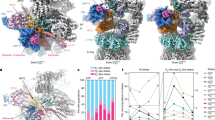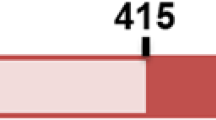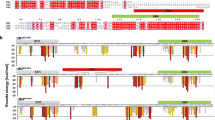Abstract
A hallmark of neurodegenerative diseases caused by polyglutamine expansion is the abnormal accumulation of mutant proteins into ubiquitin-positive inclusions1. The local build-up of these ubiquitinated proteins suggests that the proteasome machinery inadequately clears misfolded proteins, resulting in their increase to potentially toxic levels2. Inclusions may disrupt normal cell homeostasis by sequestering vital cellular factors, such as chaperones, proteasomes and transcription components3,4,6,7. Here, we used fluorescence recovery after photobleaching (FRAP) to examine the intranuclear dynamics of polyglutamine-expanded ataxin1 and inclusion-associated proteins. These experiments demonstrated that at least two types of ataxin1 inclusions exist; those that undergo rapid and complete exchange with a nucleoplasmic pool and those that contain varying levels of slow-exchanging ataxin1. Slow-exchanging inclusions contain high ubiquitin levels, but surprisingly low proteasome levels, suggesting an impairment in the ability of proteasomes to recognize ubiquitinated substrates. Proteasomes and CBP remained highly dynamic components of inclusions, indicating that although enriched with ataxin1, they are not irreversibly trapped. These results redefine our perception of polyglutamine inclusions and demonstrate the usefulness of FRAP and live cell imaging to study factors that modulate their behaviour.
This is a preview of subscription content, access via your institution
Access options
Subscribe to this journal
Receive 12 print issues and online access
$259.00 per year
only $21.58 per issue
Buy this article
- Purchase on SpringerLink
- Instant access to full article PDF
Prices may be subject to local taxes which are calculated during checkout




Similar content being viewed by others
References
Zoghbi, H. Y. & Orr, H. T. Annu. Rev. Neurosci. 23, 217–247 (2000).
Glickman, M. H. & Ciechanover, A. Physiol. Rev. 82, 373–428 (2002).
Cummings, C. J. et al. Nature Genet. 19, 148–154 (1998).
Stenoien, D. L. et al. Hum. Mol. Genet. 8, 731–741 (1999).
Warrick, J. M. et al. Nature Genet. 23, 425–428 (1999).
McCampbell, A. & Fischbeck, K. H. Nature Med. 7, 528–530 (2001).
Nucifora, F. C. Jr et al. Science 291, 2423–2428 (2001).
Phair, R. D. & Mistelli, T. Nature 404, 604–609 (2000).
Kruhlak, M. J. et al. J. Cell Biol. 150, 41–51 (2000).
Stenoien, D. L. et al. Nature Cell Biol. 3, 15–23 (2001).
Nazareth, L. V. et al. Mol. Endocrinol. 13, 2065–2075 (2000).
Mancini, M. G., Liu, B., Sharp, Z. D. & Mancini, M. A. J. Cell Biochem. 72, 322–338 (1999).
Cummings, C. J. et al. Neuron 24, 879–892 (1999).
Skinner, P. J. et al. Nature 389, 971–974 (1997).
Cummings, C. J. Thesis, Baylor College of Medicine (1999).
Fernandez-Funez, P. et al. Nature 408, 101–106 (2000).
Davies, S. W. et al. Cell 90, 537–548 (1997).
DiFiglia, M. et al. Science 277, 1990–1993 (1997).
Hersko, A. & Ciechanover, A. Rev. Biochem. 61, 761–807 (1992).
Belich, M. P., Glynne, R. J., Senger, G., Sheer, D. & Trowsdale, J. Curr. Biol. 4, 769–776 (1994).
Nandi, D., Jiang, H. & Monaco, J. J. J. Immunol. 156, 2361–2364 (1996).
Reits, E. A., Benham, A. M., Plougastel, B., Neefjes, J. & Trowsdale, J. EMBO J. 16, 6087–6094 (1997).
McCampbell, A. et al. Hum. Mol. Genet. 9, 2197–2202 (2000).
Steffan, J. S. et al. Proc. Natl Acad. Sci. USA 97, 6763–6768 (2000).
Stenoien, D. L. et al. Mol. Cell. Biol. 21, 4404–4412 (2001).
Acknowledgements
The authors gratefully acknowledge the excellent technical assistance of M. G. Mancini and K. Patel. We thank J. Botas, T. Ashizawa and S. McGuire for critical reading of the manuscript, and H. Zogbhi and C. Cummings for many helpful discussions during the course of the work. These studies were supported in part by National Institutes of Health grants RO1 DK55622 (M.A.M) and NRSA 1F32DK61859-01 (M.M.).
Author information
Authors and Affiliations
Corresponding author
Ethics declarations
Competing interests
The authors declare no competing financial interests.
Supplementary information
Supplementary figures
Supplemental figure 1 Effects mobility. A. YFP-Ub (lanes 1 and 2) or YFP-UbG (3 and 4) and were subsequently treated with (PDF 860 kb)
Supplemental figure 2Slow-exchanging inclusions contain “high” ubiquitin levels. that proteasomes are dynamic components of inclusions. Bar = 10 mm. C. To
Supplemental figure 3 Fast-exchanging inclusions have “high” LMP2 levels.
Movie 1
Fast-exchanging GFP-ataxin84Q. (MOV 2662 kb)
Movie 2
Slow-exchanging GFP-ataxin84Q. (MOV 1803 kb)
Rights and permissions
About this article
Cite this article
Stenoien, D., Mielke, M. & Mancini, M. Intranuclear ataxin1 inclusions contain both fast- and slow-exchanging components. Nat Cell Biol 4, 806–810 (2002). https://doi.org/10.1038/ncb859
Received:
Revised:
Accepted:
Published:
Issue date:
DOI: https://doi.org/10.1038/ncb859
This article is cited by
-
PQBP5/NOL10 maintains and anchors the nucleolus under physiological and osmotic stress conditions
Nature Communications (2023)
-
Prediction and verification of the AD-FTLD common pathomechanism based on dynamic molecular network analysis
Communications Biology (2021)
-
Nuclear bodies formed by polyQ-ataxin-1 protein are liquid RNA/protein droplets with tunable dynamics
Scientific Reports (2020)
-
A discontinuous Galerkin model for fluorescence loss in photobleaching of intracellular polyglutamine protein aggregates
BMC Biophysics (2018)
-
Dynamic recruitment of ubiquitin to mutant huntingtin inclusion bodies
Scientific Reports (2018)



